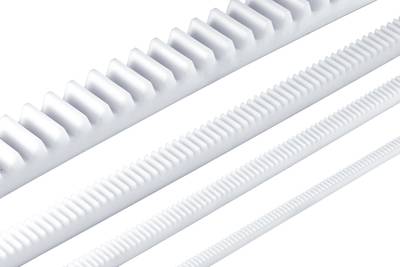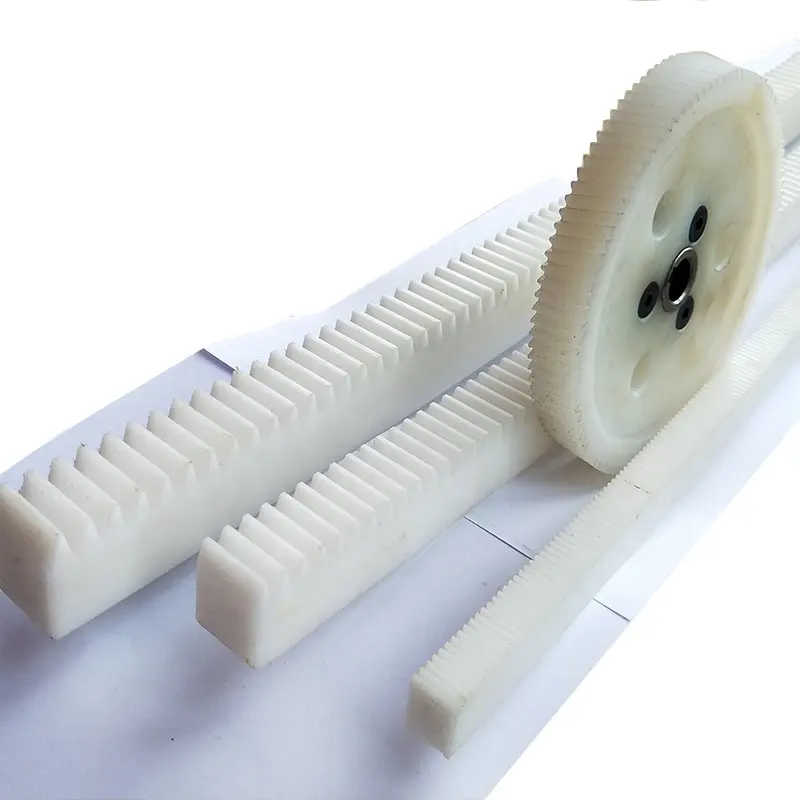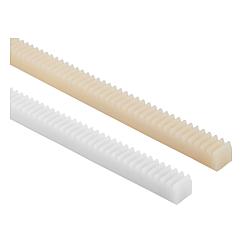Product Description
XIHU (WEST LAKE) DIS.HUA Chain Group is the most professional manufacturer of power transmission in China, manufacturing roller chains, industry sprockets, motorcycle sprockets, casting sprockets, different type of couplings, pulleys, taper bushes, locking devices, gears, shafts, CNC precision parts and so on. We have passed ISO9001, ISO14001, TS16949 such quality and enviroment certification.
Rack and gear matched together
Mould ( M0.5 — M8)
Length: 250mmr to 3000mm
Standard and special rack
Material: Mc nylon; Oil nylon + carbon (black); Oil mc901(blue); Mc nylon + mso2(light black)
Standard: RoHS
NOTE:
1)Tolerance on single pitch +/-20μ M
2)Tolerance on sum of pitches +/-30μ M on 500 mm
3)The quality grade of the toothing is from 8 to 9 at DIN 3962/63/67
4)Straight toothing
| Prossure angle 20°Material C45 | |||||||||||
| Mod. | Hp | HexS | L | ||||||||
| 500 | 1000 | 2000 | |||||||||
| Teeth No. | Lr | Weight(kg) | Teeth NO. | Lr | Weight(kg) | Teeth NO. | Lr | Weight(kg) | |||
| 1 | 14 | 15×15 | 159 | 449.51 | 0.82 | 318 | 999.02 | 1.50 | 636 | 1998.05 | 3.10 |
| 1.5 | 15.5 | 17×17 | 106 | 449.51 | 1.00 | 212 | 999.02 | 2.00 | 424 | 1998.05 | 4.00 |
| 2 | 18 | 20×20 | 80 | 502.65 | 1.40 | 159 | 999.02 | 2.70 | 318 | 1998.05 | 5.40 |
| 2.5 | 22.5 | 25×25 | 64 | 502.65 | 2.10 | 127 | 997.45 | 4.30 | 255 | 2002.77 | 8.60 |
| 3 | 27 | 30×30 | 53 | 499.51 | 3.10 | 106 | 999.02 | 6.30 | 212 | 1998.05 | 12.50 |
| 4 | 21 | 25×25 | 40 | 502.65 | 1.80 | 80 | 1005.31 | 3.65 | 159 | 1998.05 | 7.30 |
| 4 | 26 | 30×30 | 40 | 502.65 | 3.05 | 80 | 1005.31 | 6.00 | 159 | 1998.05 | 11.90 |
| 4 | 36 | 40×40 | 40 | 502.65 | 5.50 | 80 | 1005.31 | 11.10 | 159 | 1998.05 | 22.00 |
| 5 | 45 | 50X50 | 32 | 502.65 | 8.30 | 64 | 1005.31 | 17.50 | 128 | 2571.31 | 34.60 |
| 6 | 54 | 60×60 | 27 | 508.93 | 12.65 | 53 | 999.02 | 25.00 | 106 | 1998.05 | 51.00 |
| 8 | 72 | 80X80 | 20 | 502.65 | 21.40 | 40 | 1005.31 | 42.70 | 80 | 2571.62 | 85.40 |
/* March 10, 2571 17:59:20 */!function(){function s(e,r){var a,o={};try{e&&e.split(“,”).forEach(function(e,t){e&&(a=e.match(/(.*?):(.*)$/))&&1
| Hardness: | Hardened Tooth Surface |
|---|---|
| Gear Position: | External Gear |
| Manufacturing Method: | Rolling Gear |
| Toothed Portion Shape: | Spur Gear |
| Material: | C45 |
| Type: | Circular Gear |
| Customization: |
Available
| Customized Request |
|---|
Can plastic gear racks withstand variations in environmental conditions?
Plastic gear racks are designed to withstand variations in environmental conditions to a certain extent. The ability of plastic gear racks to withstand such conditions depends on the specific plastic material used and the nature of the environmental factors involved. Here’s a detailed explanation of how plastic gear racks can handle variations in environmental conditions:
- Temperature: Plastic gear racks have different temperature resistance capabilities based on the chosen plastic material. High-performance plastics like nylon, polyacetal (POM), or polycarbonate (PC) offer good temperature resistance, allowing them to operate effectively within a wide temperature range. However, it is important to consider the temperature limits specified by the manufacturer for the specific plastic material to ensure that the gear rack can withstand the anticipated temperature variations without experiencing dimensional changes or loss of mechanical properties.
- Humidity and Moisture: Most plastic gear racks are resistant to moisture and humidity to a certain extent. Plastics like nylon, polyacetal (POM), or polyethylene (PE) have inherently low moisture absorption, reducing the risk of dimensional changes or degradation in wet or humid environments. However, prolonged exposure to high levels of moisture or immersion in liquids may still affect the performance of plastic gear racks. In such cases, selecting plastics with higher resistance to moisture, such as certain grades of nylon or polypropylene (PP), can help improve their ability to withstand humid conditions.
- Chemical Exposure: Plastic gear racks exhibit varying degrees of resistance to different chemicals. Plastics like nylon, polyacetal (POM), or polypropylene (PP) offer good chemical resistance, making them suitable for applications exposed to common chemicals and solvents. However, it is important to consider the specific chemical environment and verify the compatibility of the chosen plastic material with the chemicals present. In certain cases, specialty plastics such as polyphenylene sulfide (PPS) or fluoropolymers may be required to ensure adequate resistance to aggressive chemicals.
- UV Radiation: Continuous exposure to ultraviolet (UV) radiation from sunlight can degrade the performance of plastic gear racks over time. Plastics like nylon or polyacetal (POM) may exhibit some level of UV resistance, but prolonged exposure can still lead to color fading, surface degradation, or reduced mechanical properties. In outdoor applications or environments with significant UV exposure, selecting UV-stabilized plastics or adding protective coatings can help enhance the UV resistance of plastic gear racks.
- Environmental Contaminants: Plastic gear racks can handle variations in environmental contaminants to a certain extent. Plastics like nylon or polyacetal (POM) are resistant to common contaminants such as dust, dirt, or mild chemicals. However, exposure to abrasive particles or highly corrosive substances may cause accelerated wear or damage to the gear rack. Regular cleaning and maintenance practices, along with proper sealing and protection, can help mitigate the impact of environmental contaminants on plastic gear racks.
It’s important to note that while plastic gear racks can withstand variations in environmental conditions, their performance and longevity can be influenced by the severity and duration of exposure. It is recommended to consult the manufacturer’s guidelines and consider the specific requirements of the application to ensure that the chosen plastic material and design of the gear rack are suitable for the anticipated environmental conditions.
How do plastic gear racks contribute to reduced noise and vibration in equipment?
Plastic gear racks offer several features that contribute to reduced noise and vibration in equipment. Here’s a detailed explanation of how plastic gear racks help minimize noise and vibration:
- Damping Properties: Plastic gear racks have inherent damping properties that help absorb and dissipate vibrations. Unlike metal gear racks, which can transmit vibrations throughout the system, plastic gear racks dampen vibrations, reducing their propagation and minimizing the overall noise level. This is particularly beneficial in equipment where noise reduction is desired, such as precision machinery or devices used in quiet environments.
- Non-Metallic Construction: Plastic gear racks are made from non-metallic materials, which inherently exhibit better vibration-damping characteristics compared to metal counterparts. The non-metallic construction helps minimize the transmission of vibrations from one component to another, resulting in reduced noise generation. Plastic gear racks act as effective isolators, preventing the amplification and propagation of vibrations that can contribute to noise in the equipment.
- Lower Friction and Smoother Operation: Plastic gear racks typically have lower friction coefficients compared to metal gear racks. The reduced friction results in smoother operation, reducing the generation of noise and vibrations. The smooth engagement between plastic gear racks and mating components, such as gears or pinions, minimizes the impact and contact-induced vibrations that can lead to noise generation.
- Self-Lubricating Properties: Certain plastic materials used in gear racks, such as nylon, possess self-lubricating properties. This means that they can generate a thin lubricating film during operation, reducing friction and wear. The self-lubricating nature of plastic gear racks helps maintain smooth movement and minimizes noise and vibrations associated with frictional forces between mating components.
- Resilience to Wear: Plastic gear racks exhibit good wear resistance, which contributes to the reduction of noise and vibrations over time. The plastic materials used in gear racks can withstand repeated engagement and disengagement without significant wear or deformation. This resilience to wear ensures the long-term integrity and performance of the gear racks, minimizing noise generation that can result from worn or damaged components.
- Precision Manufacturing: Plastic gear racks can be precisely manufactured with tight tolerances. This precision manufacturing helps ensure accurate tooth profile and engagement with mating gears or pinions. The precise meshing of plastic gear racks reduces backlash and tooth impact, thereby reducing the generation of noise and vibrations during operation.
The combination of damping properties, non-metallic construction, lower friction, self-lubrication, wear resistance, and precision manufacturing makes plastic gear racks effective in reducing noise and vibrations in equipment. When selecting plastic gear racks for noise-sensitive applications, it’s important to consider the specific requirements and consult with gear rack manufacturers or suppliers to choose the most suitable plastic material and design for optimal noise reduction.
What types of plastics are typically used to make gear racks?
When manufacturing gear racks, several types of plastics are commonly used due to their specific properties and suitability for different applications. Here are some of the typical plastics used to make gear racks:
- Nylon (Polyamide): Nylon is one of the most commonly used plastics for gear rack manufacturing. It offers excellent wear resistance, high strength, and low friction properties. Nylon gear racks are known for their durability, toughness, and ability to handle heavy loads. They also exhibit self-lubricating properties, reducing the need for additional lubrication.
- Polyacetal (POM): Polyacetal, also known as acetal or Delrin, is another popular plastic choice for gear rack production. It has high strength, stiffness, and excellent dimensional stability. POM gear racks provide low friction, good wear resistance, and high fatigue resistance. They are often used in applications that require precise positioning and high-speed operation.
- Polyethylene (PE): Polyethylene is a versatile plastic used in various gear rack applications. It offers good chemical resistance, low friction properties, and high impact strength. PE gear racks are lightweight, cost-effective, and suitable for applications where corrosion resistance and noise reduction are important.
- Polypropylene (PP): Polypropylene is a thermoplastic with properties similar to polyethylene. It has good chemical resistance, low moisture absorption, and excellent fatigue resistance. PP gear racks are commonly used in applications where lightweight construction, electrical insulation, and resistance to chemicals or solvents are required.
- Polycarbonate (PC): Polycarbonate is a strong and impact-resistant plastic used in gear racks. It offers high transparency, excellent dimensional stability, and good thermal resistance. PC gear racks are often employed in applications that require visibility, such as in display systems or consumer electronics.
- Polyphenylene Sulfide (PPS): Polyphenylene sulfide is a high-performance engineering plastic used in gear rack manufacturing. It possesses excellent heat resistance, chemical resistance, and dimensional stability. PPS gear racks are commonly found in applications that involve high temperatures, such as automotive or industrial equipment.
It’s worth noting that the selection of the specific plastic for gear rack production depends on factors such as the application requirements, operating conditions, load capacity, and desired performance characteristics. Different plastics offer distinct advantages and limitations, and the choice should be made based on a comprehensive evaluation of these factors.
editor by CX 2024-01-08




